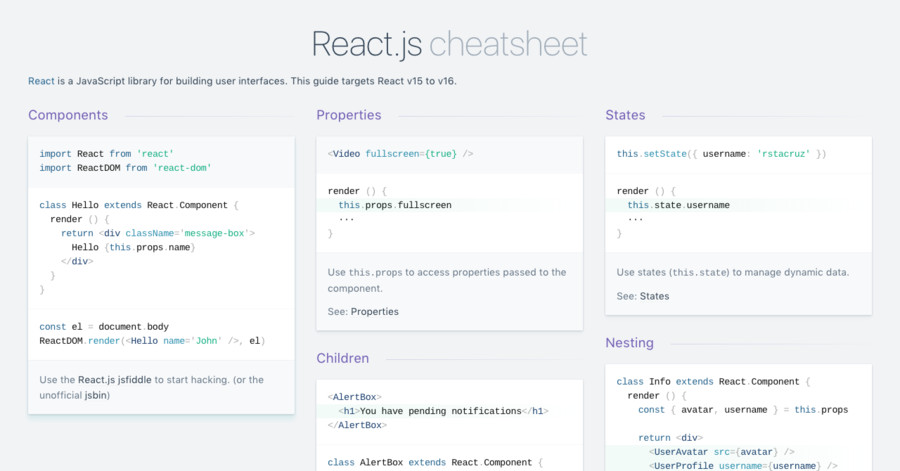The React Testing Library is a very lightweight solution for testing React components. It provides light utility functions on top of react-dom and react-dom/test-utils, in a way that encourages better testing practices. React Cheat Sheet React Podcast React Podcast landing page. For more advanced React users, who just want to relax while still learning something new, the React Podcast might be a way to go. While not a learning resource pre-se, the podcast can help you get a better grasp of the React and overall web dev ecosystem, as well as an overview of. React.Component render componentDidMount props/state dangerouslySetInnerHTML React is a JavaScript library for building user interfaces. This guide targets React v15 to v16. After making sure the elements are there, we can test the user interaction or/and how the app interacts with external data (data fetched from back-end for example). So here we go with a practical cheat sheet for React Testing Library. The elements in the lists below allows us to select components or HTML elements and make assertion about them. See Which query should I use? ByLabelText find by label or aria-label text content 1.1. GetByLabelText 1.2. QueryByLabelText 1.3. GetAllByLabelText 1.4. QueryAllByLabelText 1.5. FindByLabelText 1.6. FindAllByLabelText 2. ByPlaceholderText find by input placeholder value 2.1. GetByPlaceholderText 2.2. QueryByPlaceholderText 2.3. GetAllByPlaceholderText 2.4.
#
When it comes to testing React apps, if you google you’ll find so much info about the topic.
But all the articles, courses and any material that talks about the argument, are lacking one thing: explaining how to think about testing from a practical point of view!
There is so much about unit test, integration test, end-to-end test etc.
They explain quite well how to implement testing in your React app.
But what they don’t tell you, just because for every advanced developer who uses test is so obvious that he doesn’t think is even needed, is how to picture your testing strategy.
Maybe I don’t explain myself quite well, so let’s see in practice.
What do we need to test first of all in a React app?
Well, leaving apart unit testing, we usually test if the components are there when the app renders.
We test also if the expected behavior is the one our app is suppose to have when faced with the user interactions.
So, we must first of all, the most important, is to find out how the components and the elements in charge with the behavior have to be selected.
Because we need to have them in the test units if we want to see if them renders or have the expected behavior.

Once selected, we can test a lot of things.
We test is them are there when suppose to be there in first palace.
For example, if a component is there, if a text is there, if some HTML element is there, if a value is there etc.
If an element is there, a text or a component for example, we can assert that the app is working correctly and there are no errors, is it?
After making sure the elements are there, we can test the user interaction or/and how the app interacts with external data (data fetched from back-end for example).
Dom Testing Library
So here we go with a practical cheat sheet for React Testing Library.
The elements in the lists below allows us to select components or HTML elements and make assertion about them.
I made this list for my own use but then I thought to put it nice in an article and so make it easy for me to find it quick when I need it but also available to everyone else interested!
#.1 Selections
##If the Text, Label, Role, Alt, Value, Placeholder ARE there – positive assertion
- getByText
- getByRole
- getByLabelText
- getByPlaceholderText
- getByAltText
- getByDisplayValue
##If the Text, Label, Role, Alt, Value, Placeholder AREN’T there - negative assertion
- queryByText
- queryByRole
- queryByLabelText
- queryByPlaceholderText
- queryByAltText
- queryByDisplayValue
##If the Text, Label Role, Alt, Value, Placeholder WILL BE there – asynchronous assertion. Usually use await in front of this assertions
- findByText
- ByRole
- ByLabelText
- ByPlaceholderText
- ByAltText
- ByDisplayValue
##If there are MORE THAN ONE Text, Label, Role, Value, Placeholder in the rendered DOM, use All
- getAllBy
- queryAllBy
- findAllBy
#.2 Assertive Functions
- toBeDisabled
- toBeEnabled
- toBeEmpty
- toBeEmptyDOMElement
- toBeInTheDocument
- toBeInvalid
- toBeRequired
- toBeValid
- toBeVisible
- toContainElement
- toContainHTML
- toHaveAttribute
- toHaveClass
- toHaveFocus
- toHaveFormValues
- toHaveStyle
- toHaveTextContent
- toHaveValue
- toHaveDisplayValue
- toBeChecked
- toBePartiallyChecked
- toHaveDescription
React Testing Library Getbyrole
.3 Fire Event to test user interaction (reference: testing-library.com/docs/guide-events, testing-library/dom)
React Testing Library Docs
userEvent.type as a replacer for all the below
fireEvent.mouseOver(element)
fireEvent.mouseMove(element)
fireEvent.mouseDown(element)
element.focus() (if that element is focusable)
fireEvent.mouseUp(element)
fireEvent.click(element)

